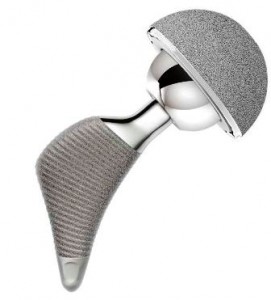Why Should I Have to Go Through a Second Hip Replacement?
When my 47-year old friend from my college days had to have her hip replaced last year, because of wear and tear on the joint, I doubt very much that anyone said to her, “I’ve got some good news and some bad news. The good news is the state-of-the-art in hip replacement has come a long way since the days of your mom or your grandmother and, once we have replaced your hip, your pain should diminish. The bad news is we’re using a DePuy ASR Hip System and they are not quite present day state-of-the-art, so you’ve got a pretty good chance of needing a new one five years from now.”
Last summer, a recall of two DePuy Orthopaedics hip replacement systems was announced after testing data showed the two systems have a 1 in 8 chance of requiring replacement within five years. The two systems, developed by DePuy, a division of Johnson & Johnson, are the ASR (which stands for Articular Surface Replacement) Hip Resurfacing System and ASR XL Acetabular System total hip replacement. Both of these systems became available in July of 2003, so only those manufactured after that date are the subject of the recall.
Replacement of any joint is quite obviously a surgery not to be undertaken lightly. While the surgical techniques have developed and improved over the years, the rehabilitation following the surgery is still difficult, involving weeks and sometimes months of physical therapy. For most joint replacement systems, the life expectancy of the artificial joint is between fifteen and twenty years – certainly not the five years projected for a significant percentage of these DePuy joint systems. In fact it is estimated that a staggering 1 out of every 8 patients will require a second surgery.
The approximately 30,000 recipients who received either one of the DePuy systems recalled last summer need to be evaluated and monitored by their implanting surgeon to evaluate failure of the joint system. Because of this unusually high failure rate, DePuy has offered to pay for the “reasonable and customary” (their words not mine) costs associated with the “revision” (again, their word) surgery.
After years of pain, which affects every aspect of one’s life prior to the first surgery, then the surgery and finally the weeks (and sometimes months) of rehabilitation following the surgery, I am not sure “reasonable and customary” compensates someone who has to be told that they, once again, must go through weeks of pain and physical therapy because a manufacturer did not properly evaluate a medical device placed in you. These patients not only face repeated physical pain, but also will be denied, again, the experiences of working to earn a living; chasing their kids or grandkids around the yard; the enjoyment of travel; and will be restricted in many aspects of their life.
How can this happen? It is about a corporate citizen, like Johnson & Johnson, choosing profits over the safety of patients. It is about minimizing development costs and rushing a product to market, for use inside human bodies, before appropriate testing and evaluation is done by the manufacturer.
The good news is….well, there is no good news.
Share This



